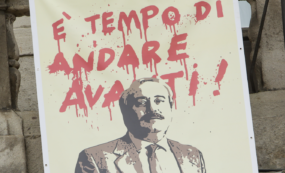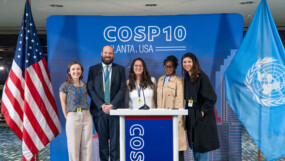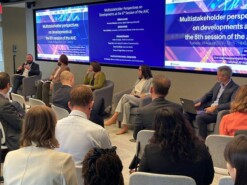Posted on 19 Aug 2022
This year’s UN High-level Political Forum on Sustainable Development, held in New York in July, focused on Sustainable Development Goal 15: Life on land. The Global Initiative Against Transnational Organized Crime (GI-TOC) co-organized a session with the Wildlife Justice Commission about innovative responses that target different stages in international trafficking flows.
As part of Sustainable Development Goal 15, targets 15.7 and 15.C seek to ‘eliminate poaching and trafficking of protected species’ and ‘combat global poaching and trafficking’. Speakers at the GI-TOC–Wildlife Justice Commission session shared their experiences of the progress made in disrupting the illicit wildlife trade, but also outlined key remaining challenges and provided recommendations to member states for further improvements to the global response.
Olivia Swaak-Goldman, executive director of the Wildlife Justice Commission, highlighted the need for a multi-layered approach in disrupting and dismantling criminal networks, explaining how key legislative changes and increased law enforcement efforts could change the dynamics of environmental crime in terms of geographical displacement, and decline in prices and demand. She pointed to the Chinese ivory ban, enacted on 31 December 2017, as a policy intervention that has had a significant impact on the criminal landscape. However, wildlife crime remains a serious problem and, although it has started to attract more attention, law enforcement authorities continue to be reactive rather than proactive.
Swaak-Goldman made three key recommendations to states: firstly, to make greater use of specialized investigation techniques, which have proven to be effective; secondly, to increase their intelligence capacity as part of the overall disrupting strategy, and to share intelligence transnationally. Sharing intelligence creates a global picture of the criminal network for authorities and can help states make better choices with their limited resources, ultimately achieving a bigger impact. Lastly, considering that the revenue made from wildlife crime often leaves the jurisdiction where commodities are sourced, and locals do not profit from it, financial investigation analysis should be used consistently and systematically. This would aim to impact the profitability of the transnational syndicates that are behind illicit wildlife trafficking, and asset recovery could help local communities preserve their natural resources.
Charity Apale, project manager at the Zoological Society of London in the Philippines, highlighted the important role of communities as change agents in countering wildlife trafficking and poaching. She cited the case of applying community-based social marketing to change the behaviour of consumers of Palawan pangolin meat, an initiative through which Apale is hoping to generate active and sustainable support to protect pangolins. A key element of this programme includes the creation of alternative livelihoods for people that share their habitat with this species.
Simone Haysom, the GI-TOC’s thematic lead on environmental crime, reiterated that a holistic approach is needed, one that must include action to diminish demand and intervention in retail markets. Over the past two decades, the internet has revolutionized wildlife markets and the online trade in endangered species and their parts. But compared to physical markets, online e-commerce, where many products containing processed animal parts are found, is poorly regulated.
The live-animal trade is also embedded in social media and large classified advertising platforms, which have the effect of normalizing the consumption of these products. Haysom offered recommendations such as the creation of clear baselines to measure the extent of illicit wildlife trade content online, to hold companies accountable and to assess the effectiveness of regulation. Slightly increased involvement of regulators, she argued, would discourage the bulk of buyers and traders, who are not highly motivated. In addition, demand-reduction campaigns targeting the motivations of key consumers could be an important method of crime prevention.
Lastly, Naomi Doak, regional coordinator to counter wildlife trafficking at the Wildlife Conservation Society, underlined that despite progress made in this field, the situation is still serious and increased political attention is not necessarily translating into improved law enforcement responses. Countries are still struggling to turn momentum into action and many wildlife criminals and businesses remain at large. This is due to persistent corruption and insufficient resourcing for responses. Doak also criticized the lack of evidence gathering by NGOs and governments, and the ineffectiveness of popular modalities of response, such as taskforces. Governments should prioritize wildlife trafficking, considering the risk to public health seen in the COVID-19 pandemic, and invest in training effective leaders who can pursue efficient strategies to address poaching.
Panellists shared their insights on the role and responsibility of tech companies, possible amendments to the Convention on International Trade in Endangered Species of Wild Fauna and Flora, and barriers to international cooperation. Panellists outlined the complexities of this global, multifaceted problem, and the session provided practical steps to harness the growing political attention to wildlife trafficking and turn it into meaningful action.
The Illicit Wildlife Trade Developments, Responses, and Lessons Learned to Support SDG 15.mp4 from Wildlife Justice Commission on Vimeo.



